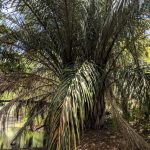TREE LIFE
February 2019
MASHONALAND CALENDAR
Unfortunately, due to the hassles of getting sufficient fuel for normal activities, we had no option but to cancel the out of town outings last month. However, with a bit of luck, we will get to those venues this month. If you are unsure about whether or not there is an outing, please check with a committee member.
Saturday February 2nd: National Botanic Garden walk. This is a wonderful time of year in the Gardens. We will continue with figs as the main theme but if we come across anything interesting then we’ll have a look at it! Join us for a 1.5 hour walk, we will start at 08:30am from the usual place – the car park.
Sunday February 17th: We will be visiting a very favourite spot at the Botanic Gardens Extension at Christon Bank. Christon Bank is situated about 30km north of Harare. It is an area of rocky hillsides and Brachystegia boehmii dominated woodland near the Mazowe River. Several properties were donated to the National Botanical Gardens in the seventies and have been maintained and protected under the name Mazowe Botanic Reserve. At this time of year there could be some interesting terrestrial orchids as well. It is a super place. Bring your chair, lunch, sun block and cooler bag and come for a really good day out. You do not have to be a member to join us for the day. We start at the venue at 9:30am
For those wanting a lift, we will meet at CABS Northridge Park at 8:40 am and leave at 8:50 am.
Saturday February 23rd: We will visit another favourite spot of the Tree Society members and birders, Haka Game Park. I will try to get a reduction in the entrance fee for our members and you will be told in the notice just before the meeting. We will meet at the First Picnic Site after entering from the Cleveland entrance and decide where we will botanise then, it depends on whether we can cross the little river or not. This is always a happy venue. Bring a thermos flask or cooler bag for after the walk. We will start at 2:30pm at the venue.
Please contact Tony Alegria on 0772 438 697 for any other information.
Tree Society Botanical Garden Walk 5th January 2019
Fourteen of us assembled for the first walk in 2019. The regular Tree Society members included Tony, Mark, Teig, Jim and Ann. Richard, Jane, Julie and six new faces, who were very welcome. The morning was cool and cloudy, but not raining.
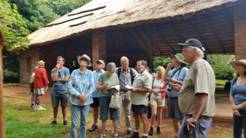
Group discussing a point. Photo: Julie Stevenson
We set off on the path towards the tea room, our first stop by one of our favourite small trees, Homalium abdessammadii. Zambezi brown-ironwood. The flowers are small, intricate and attractive on short branched spike like heads, greenish white with reddish anthers.
The main theme of the morning was to concentrate on Figs, Family Moraceae, genus Ficus. There are a large number planted in the Gardens, many of the indigenous species and several exotic species as well. Tom certainly created a wonderful collection of figs. Features which distinguish the genus Ficus are:- Presence of a milky latex. Alternate spiraling leaves, simple with conspicuous stipules enveloping the leaf bud which fall off leaving a conspicuous scar. The leaf stalk looks as if it has been stuck on and often at an angle to the leaf. Leaves usually have three main veins from the base. The fruit is a receptacle which form a fleshy sphere with or without a stalk. These can be solitary, in pairs or heavy clusters. Flowers: sexes separate are produced inside the receptacle. The fruit is a very small nut. Most figs are edible if somewhat insipid.
Ficus trichopoda, (Syn F. hippopotami) has small figs on stalks growing from new growth in the axles of the leaves. The leaves are very large. This is the swamp fig from the Mozambique and Natal coastal swamps.
There is a sausage tree, Kigelia africana growing next to the path. Not a robust tree as it is growing in deep shade.
We next saw a large fig tree with large fruit from the Haroni Resitu Valley – Ficus vallis- choudae. Haroni fig. The leaf stalk is at a pronounced angle. There is an impressive Strangler fig nearby, but this is not on another host tree, but has re rooted after some set back. Some figs do grow on other trees, they germinate in the axle of a branch and the roots grow down and establish themselves around the host tree. They take up all the nourishment and the host tree will eventually die. It is not physically strangled, it is starved to death. This one is Ficus bizanae. Pondo fig. The Ficus bubu planted by Tom has very pale bark and leaves with very long petioles. It grows on the Mozambique and Zimbabwe border. The figs grow on knobs on the branches.
We then headed across to the forest but en route we looked at a young Acacia xanthophloea, the fever tree invoked some discussion. It is a lowveld tree from the banks of the Limpopo, but it grows into a much larger tree in Harare where it has been planted extensively in gardens and along streets. Rudyard Kipling wrote of the great, grey, greasy Limpopo all set about with Fever Trees.
On the edge of the forest we saw Phyllanthus ovalifolius, the small fruited Potato bush. We also saw the Ficus capreifolia, the sand paper fig. The leaves are very rough and have been used as sandpaper in the preparation of hides and polishing the wood of bows.
Heading into the forest we marveled at the size of the Mahogany, Khaya anthotheca, the “big tree” in the Chirinda forest and some Albizia sp. Also saw Clausena anisata whose leaves have an unpleasant smell and occurs in low altitude woodland. We also looked at:
A large spreading Ficus chirindensis. Fairy-tale fig which has knobs along the branches where the figs grow.
Trichilia emetica has more veins on the leaves than T. dregeana. T. emetica is riverine and grows on the banks of the Zambezi, T. dregeana is the forest species which grows in the Haroni Risitu area. The fruit of T. dregeana are more rounded.
3 Millettia dura have grown tall and imposing – they have purple pea flowers.
Rothmannia manganjae was in flower, with striking cream tubular blooms with maroon markings in the throat. There are very few flowers this year compared to the mass of flowers last year.
Ficus sycomorus a large spreading tree has distinctive greenish yellow smooth bark. The leaves are almost circular and are rough to the touch. The figs are large in heavy branched masses on the trunk and main branches.
Thank you Tony and Mark for a very interesting and informative morning walk
-Ann Sinclair
Saturday, 22 September, Saturday afternoon outing to Prince Edward School
On Saturday, 22 September, we visited the arboretum at Prince Edward School in Harare. I thought the outing would focus on cultivated trees, but it turned out to be a far richer experience than that. Here are FIVE things to know about this site….
It has EXOTIC trees
Just off the car park we examined an ancient Eucalpytus cinerea with silvery, stalk-less leaves. The leaves give the tree its common name: Silver dollar tree. A native of Australia (where else?) this specimen, with its great height, ample girth and deeply-fissured bark, must be nearly as old as the 120-year-old school itself. Near to it was a small tree with long, wide and deeply-lobed leaves. This was the Tree poppy, Bocconia frutescens. It’s native to central and South America, though it’s reportedly become invasive in places like Hawaii.
We also stumbled upon Fernandoa abbreviata — native to Malawi. It stood bare-branched along the school’s eastern boundary. Unfortunately, its spectacular orange and yellow flowers had already fallen.
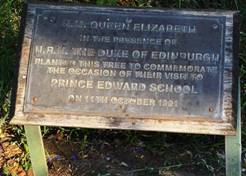
Plaque commemorating the visit of Queen Elizabeth to the school. Photo: Ryan Truscott
It has HISTORIC trees
The Queen’s Quad is at the centre of the arboretum, and growing in the middle of it is a Paperbark acacia, Acacia sieberiana, planted in October 1991 by Britain’s Queen Elizabeth. Paperbarks can grow up to look rather regal – though this one, planted on the cusp of Zimbabwe’s worst drought in living memory, obviously had a bad start in life, and is now overshadowed by some other trees in the quad (more about them later).
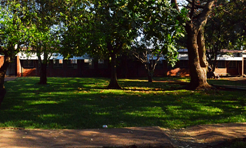
Queen’s Quad at Prince Edward School. Photo by Ryan Truscott
Beyond the quad we scrunched our way noisily through thick leaf litter to reach another (allegedly) historic tree: this time a Giant-leaved fig, Ficus lutea, said to have been planted by THE Prince Edward, although this could not be verified and there is no commemorative plaque to prove it.
It has INDIGENOUS trees
Probably the most striking of these is a Red mahogany, Khaya anthotheca, with a massive trunk towering almost as high as the apartment blocks across the road. This is the proverbial “Big Tree”, like the one in Chirinda Forest. Next to it is an equally large Albizia gummifera, Smooth-barked flat-crown, another dominant species from the evergreen forests of Manicaland. Both the mahogany and the flat-crown are evidently enjoying life in the Highveld.
It has some impressive FLOWERING trees
The first to catch our eye was a Cape chestnut, Calodendrum capense. Its beautiful flowers, with their multiple layers of sepals, petals and false sepals, were just emerging. The tree must be a spectacle when in full bloom.

Cape chestnut, Calodendrum capense. Photo by Ryan Truscott
The Queen’s Quad – the jewel in the crown of the arboretum. Here we stood to admire the flowers. There were flowers on a Rothmannia manganjae, Scented bells; flowers dripping nectar from a Weeping boer-bean, Schotia brachypetala as a variable sunbird chittered excitedly in its branches; and pink flowers carpeting the ground beneath a Pink jacaranda, Stereospermum kunthianum.

Rothmannia manganjae. Photo: Ryan Truscott
It has WEIRD and WONDERFUL trees
The one that stole the show was the Rain tree, Philenoptera violacea, growing near the main school gate. It lived up to its name, raining down profusely as we stood beneath it. The ‘rain’ is caused by spittle bugs in the branches that suck the sap from the tree and excrete it as almost pure water. The phenomenon isn’t unique to the Rain tree though. As Tony Alegria pointed out, the spittle bugs “colonise everything from Erythrinas to privet hedges.” He was proved right a little later when we got rained on by a Quinine tree, Rauvolfia caffra. Other weird and wonderful trees in the arboretum included a Toad-tree, Tabernaemontana elegans and the Poison-bride’s bush, Pavetta schumanniana: its leaves were peppered underneath with tiny dots caused by bacteria, a unique characteristic of this species.
All in all – a very stimulating afternoon. Perhaps the Tree Society should get permission to label all the trees in the arboretum to promote interest among pupils at the school.
-Ryan Truscott
Tree of the month – Kenya croton
Our tree of the month is the Kenya croton, Croton megalocarpus. It is very common in gardens in Harare, and there have been some magnificent flowering specimens seen around the city this December. As the English name implies, it’s not indigenous to this country.

Kenya croton, Croton megalocarpus flowers. Photo: Mark Hyde
It grows naturally throughout East Africa, from Mozambique to Somalia. In Kenya the nuts (which aren’t edible by the way) are touted as the next big thing in biofuel, and the expressed oil can be used to run diesel generators and tractors. Something for fuel-starved Zimbabweans to consider?
Fast growing
The good thing about having fuel-bearing trees like the Croton, experts say, is that they don’t take up space in farm lands that could be more usefully used to grow food.
The Kenya croton, which can reach heights of up to thirty metres, is popular with Harare gardeners, presumably because of the thick broad canopy of velvety leaves that provide ample, year-long shade.
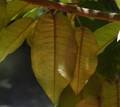
Croton megalocarpus pale underleaf. Photo: Ryan Truscott
The two-toned simple leaves themselves are rather fetching – they droop from the branches on long stalks exposing their pale, brown-flecked undersides. The grey, slightly fissured bark is often clad with lichen.
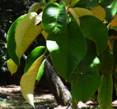
Shiny green upper side of Croton megalocarpus leaves. Photo: Ryan Truscott
It’s features like these that probably make it a favourite tree to have in gardens and car parks alike. It’s also relatively fast growing and the roots aren’t invasive, which means it can be planted close to buildings.
Green deserts?
On the whole it’s a highly understated but useful tree. The problem, for me, is that it’s not indigenous to Zimbabwe. As one bird loving gardener once told me, all these non-native species are turning our gardens into green deserts, devoid of useful forage for local insects and birds.
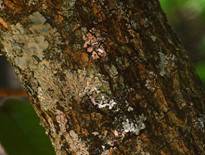
Bark of Croton megalocarpus. Photo: Ryan Truscott
So the burning question remains: what indigenous substitute is there to the rather wonderful Kenya croton? To find out, I asked two nursery owners from opposite sides of the country.
Sally Preston of Hivu Nursery in the Vumba mountains says she’s not surprised the Kenya croton is a hit. “It is a fantastic shade tree and excellent for a parking area with not much mess,” she says. Being a Vumba person, she suggests the Albizia gummifera, the Smooth-barked flat-crown, as an alternative. It’s a dominant species in her neck of the woods.
Safe choice
Lene Lauritsen of Huntsman Indigenous Trees in Bulawayo describes the Kenya croton as a “safe choice” that might have been made when indigenous alternatives weren’t readily available in local nurseries. “People are often very conservative and scared to make a different decision,” she adds. So, what would her local alternative be?
There are all sorts of things to consider, she notes. “Soil comes in, the region in which to plant; rainfall matters, frost if any and then — should it be a small tree, a big tree or a giant, or must it have flowers?” She adds: “I have so many favourites but one that never gets used that I love is Afzelia quanzensis (the Pod mahogany).”
So, there are two local options for us to consider. I must admit though: I’ve seen some pretty gigantic Pod mahogany trees and Albizia gummiferas growing in the wild. Which may mean that for the less daring or the less imaginative the Kenya croton will remain a favourite fall-back option.
-Ryan Truscott
TONY ALEGRIA CHAIRMAN


